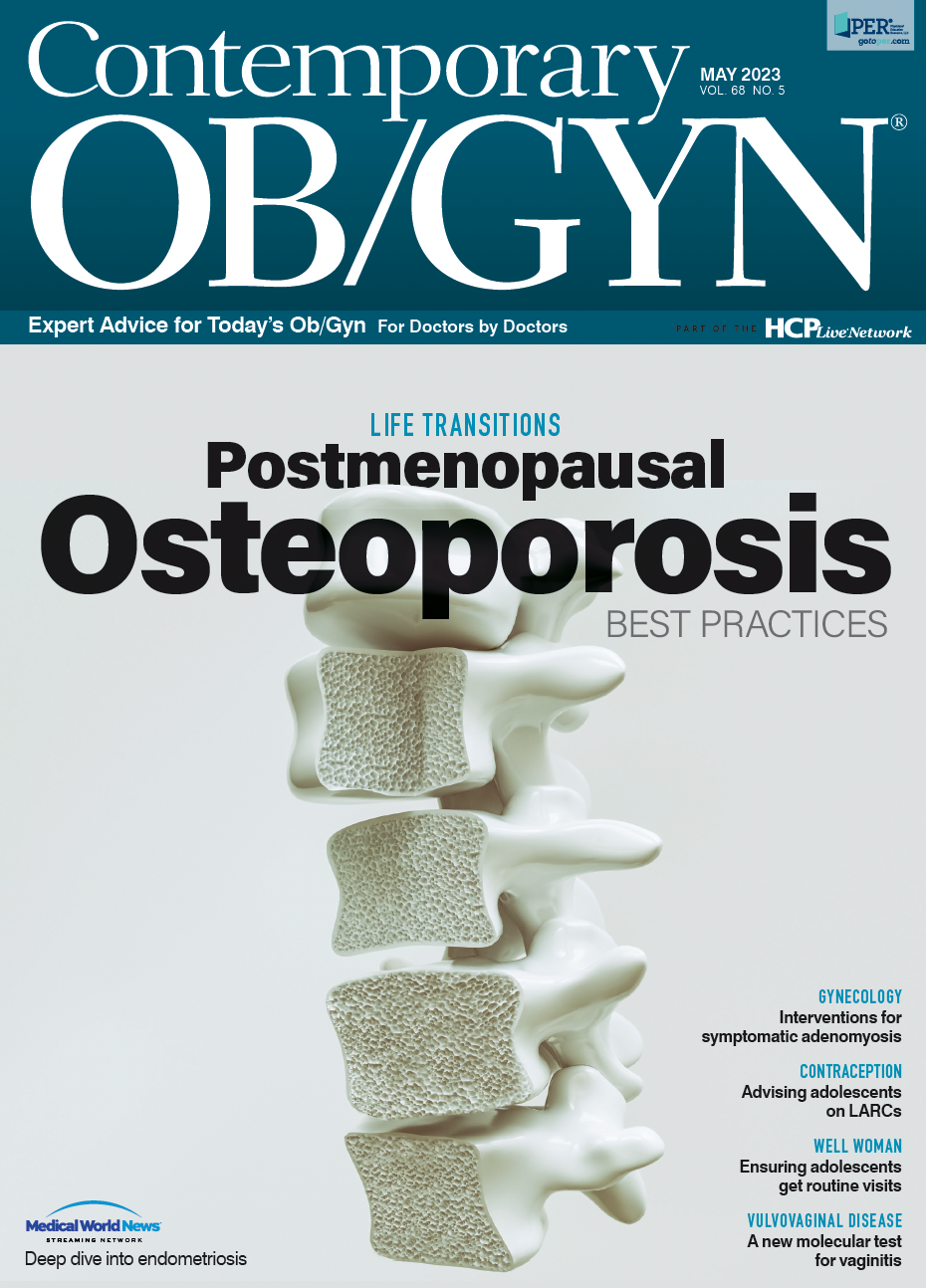Is this a missed diagnosis of abnormal uterine bleeding?
Is this a missed diagnosis of abnormal uterine bleeding? | Image Credit: © ARAMYAN - © ARAMYAN - stock.adobe.com.

The case
A 46-year-old gravida 2, para 2002 patient presented to her ob-gyn office complaining of heavy uterine bleeding that often soiled her clothes and bedsheets. A physician assistant (PA) saw her and performed a pelvic exam that was reported as normal. Her calculated body mass index (BMI) was 41.56 kg/m2. The PA performed a transvaginal ultrasound, which the PA interpreted as negative. An endometrial biopsy was not performed. Eighteen months later the patient presented again with persistent heavy bleeding. She was seen by the same PA, who reported a normal pelvic examination and performed another transvaginal ultrasound, which again was reported as negative.
Ten months later the patient saw another physician, who performed an endometrial biopsy that revealed poorly differentiated adenocarcinoma of the endometrium. Despite undergoing surgery, radiotherapy, and chemotherapy, the patient succumbed to her disease 9 months after diagnosis.
Allegations
The patient’s family sued the first physician, the PA, and the physician’s corporation for missed diagnosis, resulting in progression of disease to the point where successful treatment was not possible. This delay was alleged to be the proximate cause of the patient’s subsequent death.
Discovery
An examination of the records revealed that no images had been retained from the original ultrasound, which had not been reviewed by the physician. Furthermore, no formal report was found in the chart. There were 2 thermal print images found for the ultrasound performed at the second visit, which revealed a thickened (16.8 mm) heterogeneous endometrium.
During the defendant physician’s deposition, it was admitted that the physician never reviewed the PA’s notes and that no protocols were in place regarding PA supervision or scope of practice. The physician does not personally perform gynecologic ultrasound nor routinely interpret these studies, relying primarily on a sonographer who is present 2 days a week and on the PA. The physician did not review the ultrasound images obtained by the PA. It was further determined that the practice does not have a policy for retention of ultrasound images.
Result
After defendant’s deposition, the parties reached a settlement for $800,000 without further discovery.
This unfortunate case highlights the legal concept of respondeat superior, which finds the employer liable for an employee’s wrongdoing if committed within the scope of their employment.1 Although no protocols existed, the physician routinely allowed the PA to perform and interpret ultrasound studies, hence they were considered within the scope of PA practice and the physician was liable for the errors of the employee.
It was further determined that the state where this occurred has specific regulations and guidance regarding the proper supervision of PAs. The practice and the supervising physician failed to meet these requirements, placing the physician at even greater jeopardy with the state medical board.
Learning points
Evaluation of abnormal uterine bleeding
This patient was at increased risk for endometrial cancer due to her increased BMI. Obese women, even those less than 45 years of age, are at risk, with more that 70% of those in this age group with endometrial cancer having a BMI greater than 30 kg/m2.2 Ultrasound-measured endometrial thickness of 4 mm or smaller can be used as a screening tool to defer endometrial biopsy in postmenopausal patients with uterine bleeding.3 However, endometrial thickness is of limited value in excluding endometrial cancer in premenopausal women. The American College of Obstetricians and Gynecologists (ACOG) recommends endometrial biopsy as a first-line test in patients with abnormal uterine bleeding (AUB) who are older than 45 years. Even in younger patients, ACOG recommends an endometrial biopsy if there is persistent AUB. One should not rely on serial measurements of the endometrial thickness to determine whether a biopsy is warranted. Having persistent AUB, this patient should have undergone an endometrial biopsy early in her evaluation. Regardless, the second ultrasound demonstrated an abnormal endometrial appearance that warranted further evaluation with endometrial biopsy, perhaps augmented with a sonohysterogram. The failure to respond to patient’s clinical risks and abnormal ultrasound findings was crucial in the decision to settle this case.
Supervision of advanced practice providers
Although advanced practice providers (APPs) like nurse practitioners, midwives, and physician assistants are gaining greater independence to practice, physicians must familiarize themselves with their state’s regulations and guidance. If supervision is required, the practice should have policies and protocols in place that specify the APP’s scope of practice, when a referral to the supervising physician is required, and how to appropriately document APP supervision.
APP performance and interpretation of gynecologic ultrasound
The American Institute of Ultrasound in Medicine (AIUM) offers guidance on the training of individuals who perform ultrasounds4 and the required componentsof a pelvic ultrasound examination.5 It also has a clear official statement regarding who should supervise and interpret ultrasound exams (physicians, with few exceptions)6 and how to appropriately document such examinations.7 This particular ob-gyn practice failed to meet these requirements in several ways. The physician provided no oversight to the PA, who had no formal training, while performing incomplete pelvic ultrasounds. The current standard is that sonographers who perform pelvic ultrasounds should be credentialed in this area.7 Although AIUM has a practice parameter for APPs performing limited obstetrical ultrasounds, it has no similar parameter for pelvic ultrasound examinations by APPs.
Retention of ultrasound images
Ultrasound images should be kept for the statute of limitations (SOL) period in the given state or jurisdiction. Preferably, images should be stored in digital format rather than thermal prints. Storage alternatives include a hospital’s PACS (picture archiving and communication system), an office-based server, a cloud computing provider, the scanning of thermal prints into the electronic health record, or the monthly copying of images from the ultrasounds’ hard drive to a DVD that is then retained for the SOL.
Reference
1. Garner BA, ed. Black’s Law Dictionary. 7th ed. Thomson Reuters;1999:1313.
2. Pellerin GP, Finan MA. Endometrial cancer in women 45 years of age or younger: a clinicopathological analysis. Am J Obstet Gynecol. 2005;193(5):1640-1644. doi:10.1016/j.ajog.2005.05.003
3. Committee on Practice Bulletins—Gynecology. Practice bulletin no. 128: diagnosis of abnormal uterine bleeding in reproductive-aged women. Obstet Gynecol. 2012;120(1):197-206. doi:10.1097/AOG.0b013e318262e320
4. Employment of credentialed sonographers. AIUM. November 12, 2020. Accessed March 19, 2023. https://www.aium.org/resources/official-statements/view/employment-of-credentialed-sonographers
5. AIUM practice parameter for the performance of an ultrasound examination of the female pelvis. J Ultrasound Med. 2020;39(5):E17-E23. doi:10.1002/jum.15205
6. Supervision and interpretation of ultrasound examinations. AIUM. November 12, 2020. Accessed March 19, 2023. https://www.aium.org/resources/official-statements/view/supervision-and-interpretation-of-ultrasound-examinations
7. AIUM practice parameter for documentation of an ultrasound examination. J Ultrasound Med. 2020;39(1):E1-E4. doi:10.1002/jum.15187

Newsletter
Get the latest clinical updates, case studies, and expert commentary in obstetric and gynecologic care. Sign up now to stay informed.
